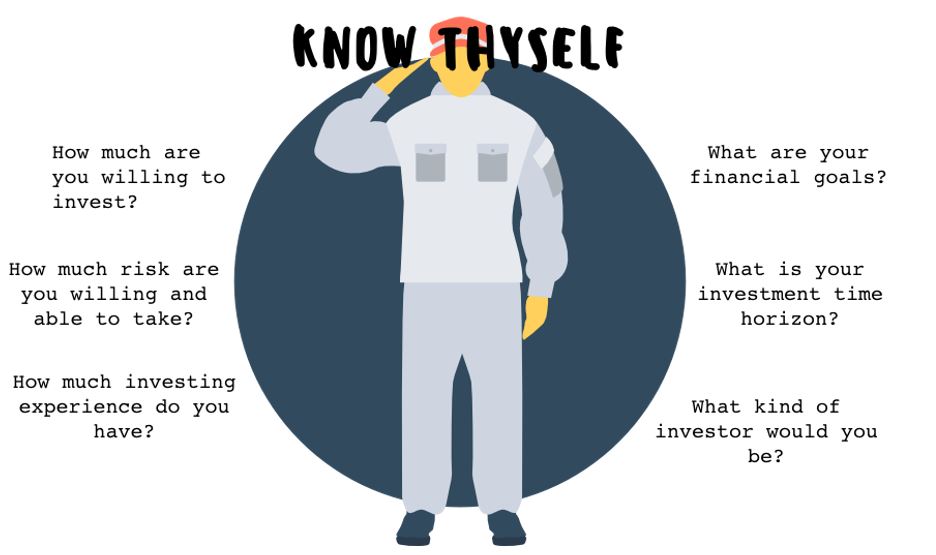
As Sun-Tzu has succinctly and famously put it, “Know thy self, know thy enemy. A hundred battles, a hundred victories”.
If you are planning on investing, it would pretty much be like going to war, and your enemy is the market. Unfortunately, the reason many DIY investors die on the battlefield is due to skipping the first step – getting to know themselves.
Know Thy Self
The first and most important step when investing on your own is to understand yourself and devise a comprehensive financial plan. The plan should highlight your financial goals as well as your risk appetite and risk capacity.
To begin, here are some important questions you should ask yourself:

These are just some guiding questions that would help you along. Alternatively, you could use any of the many tools available online, such as the risk tolerance questionnaire by the Central Provident Fund (CPF) Board. This step is essential. It would be what you would need to determine your investing strategy, which we will elaborate on in a while.
For example, if you have kids and your main financial goal is to be able to provide for their tertiary education, the returns and hence the risk you would be taking in your strategy would not be as high as say, if you were planning for a luxurious lifestyle.
The second part to knowing yourself is deciding the arsenal most suited for you in your investing strategy. If you thought the first part was easy, here’s what is difficult. This is where most DIY investors either struggle with, fail at, or completely miss out on.
The following are considerations you should have when deciding your weapons:
a) Type of assets

Is it bond, equity, real estate, mutual funds, index funds, just to name a few of the many, that you want to invest in? Or would you want a combination of the above to form your arsenal?
b) Scale and number of assets

Decide the number of each type of assets you would like to include in your portfolio.
The more diversified your portfolio is, the lower the risks. Having many different types of weapons would deter your enemy no matter where it intends to strike you – if on land you have well-equipped tanks and if in air, you have fighter jets. However, your upside decreases as well. If your machine guns are doing particularly well, your success is limited as you might only have a small amount of it.
Remember, the lower the risks, the lower the returns, and vice versa.
c) Frequency of attacks

The more frequent you trade, from say once every month to once every minute, the higher the trannsaction cost. Imagine trying to attack your enemy frequently – the cost can be tremendous.
Also, think about the heavy commitment of time and effort you would need to keep yourself constantly updated and to monitor the market to capture any inefficiencies.
Know Thy Enemy
Now that you have a comprehensive understanding of what you want and how you are going to achieve it, it is then important to know the market before you act.
Be prepared to do extensive research and reading. When investing, you are not just investing money but a lot of your time as well to keep up with your commitment. In fact, let’s take a look at the daily routine of typical successful DIY investor and how he seeks to understand his enemy.

Active investing is tough – despite its potentially attractive returns, it is tedious, time-consuming and what’s worse is that you might not always get it right. However, don’t despair – another simpler approach to DIY investing is passive investing, the practice of holding for long-term a well-diversified portfolio, which we would discuss further in a separate article.
Meanwhile, go put your armour on! The art of war takes time to master as well.













